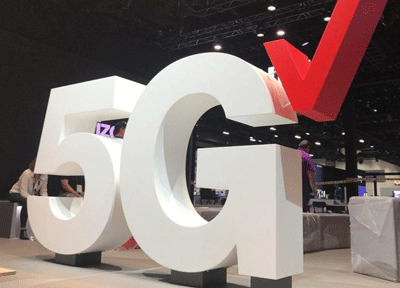The coming Fifth Generation (5G) mobile bandwidth speeds will be far more than just a faster connection, transforming medicine, transportation, media and more. Center director Jeffrey Cole explains.
______________________________
By Jeffrey Cole
 We remember that 4G made our apps run faster on our smartphones than they did on 3G. The increased speed was useful (and quickly addictive) but not transformational. Once we began using broadband, we were never able to go back to dialup. And just as with 2G, 3G, and 4G, as the faster speeds were available we began to use apps and services that did not work at slower speeds.
We remember that 4G made our apps run faster on our smartphones than they did on 3G. The increased speed was useful (and quickly addictive) but not transformational. Once we began using broadband, we were never able to go back to dialup. And just as with 2G, 3G, and 4G, as the faster speeds were available we began to use apps and services that did not work at slower speeds.
Some people think that the same thing will happen with 5G—that 5G is to 4G as 4G was to 3G. This is a mistake. Fifth Generation (5G) cellular technology is faster than 4G and will also quickly become addictive, but it will be more than an incremental change.
The difference is that 5G will transform the role of wireless in our lives, bring essential new services, and extract a large price from some of the legacy services and players. There will be lots of big winners—the consumer more than anyone else—and lots of big losers.
For the entire digital era, there have always been compromises when using wireless technology. The range and, more importantly, the speed of wireless has always trailed that of wired communication. That ends with 5G.
_____________________________________________________________________________________________
The mobile companies (Verizon, AT&T, Sprint, and T-Mobile as well as smaller players) are preparing not only for a major war against the cable companies but also amongst each other. The need to compete effectively against looming threats—5G chief among them—is one of the main arguments used by Sprint and T-Mobile to the government in support of their merger. They feel they need the scale and power a merger will create in order to compete.
______________________________________________________________________________________________
Only in the last few years have we thought of wired broadband the way we think of electricity. For all of our lives, when we enter our homes and turn on a light switch we have never had to wonder or ask if the electricity will be fast enough to power the our devices (brownouts notwithstanding). We don’t need to know anything about the strength of electricity or which “brand” it is: it just does what we need it to do.
In the last few years the same has become true of wired broadband: it’s fast enough to do almost anything we need. Spectrum, one of the nation’s largest broadband providers, starts its broadband service at 200 Mbps, an unthinkably fast base speed only a few years ago. There is almost nothing you can do at 200 Mbps where you find the need for even more speed.
We are about to enter an era where the differences and compromises between wired and wireless disappear, and we will never need to think about speed again.
When 5G is fully deployed in the next two years and we acquire the devices that support 5G, we will never look back.
Of course, that means our smartphones will work at dizzying speeds. The annoying spinning wheel we watch while digital content loads or buffers will disappear.
Not just faster, different
What really sets 5G apart is the new and vital services that will be enabled. These include:
1. Telemedicine — With 5G, the lag in mobile communication disappears for almost all applications. Distance surgery and other forms of medicine will be administered in real time with no impediments. Doctors will be able to remotely supervise many medical procures at the same time. No longer will patients who require difficult surgeries have to travel to a major city. Even the smallest towns will have access to superb remote medical care.
2. Driverless cars — The technology to make cars driverless is already here. These cars are being successfully tested on roads around the world. What is missing is the infrastructure on the roads that will allow millions of cars to communicate with each other and be safely routed through our cities. 5G will provide the essential wireless infrastructure that will enable autonomous driving.
3. 5G could be a cable killer — The last ten years have been difficult for cable and satellite companies. Over the top (OTT) services (like Netflix and Hulu) that bypass cable and come directly to the consumer through the internet are causing significant cable cutting throughout America. Cable companies have lost millions of television customers and will lose many more. The only good news is that they have become the providers of Internet service to most households. Broadband is a much more lucrative service for cable companies that television service. There are no escalating channel fees or content to program.
Now internet service through cable is at risk. Wireless companies will be able to offer Internet through their systems allowing consumers to eliminate cable companies for all services. Consider that 95% of Americans have cellular service, while cable has fallen to somewhere in the 70-76% level. It will be far easier for mobile companies to offer internet than it will be for cable companies to attract mobile users (although they are trying).
4. Internet of things (IoT) — Homes sharing broadband are already experiencing real “traffic jams.” In addition to each member of the family using smartphones, tablets, computers, television with Netflix and other OTT connections, now the appliances and mundane devices in the home need bandwidth. These include security systems (door bells), lamps, refrigerators, toasters, tooth brushes and much more. Much of the additional demand for bandwidth will be satisfied by 5G.
Looming bandwidth wars
The mobile companies (Verizon, AT&T, Sprint, and T-Mobile as well as smaller players) are preparing not only for a major war against the cable companies but also amongst each other. The need to compete effectively against looming threats—5G chief among them—is one of the main arguments used by Sprint and T-Mobile to the government in support of their merger. They feel they need the scale and power a merger will create in order to compete.
Last week, Verizon turned on its first 5G systems in Chicago and Minneapolis. Speeds reached up to 1 Gbps, ten times faster than the fastest LTE speeds. Verizon plans to roll out to more cities in the near future.
Verizon plans to bet the company on 5G. Their new CEO, Hans Vestberg, came from Ericsson, one of the two leading companies in the world building 5G systems. His appointment clearly demonstrates Verizon’s commitment to infrastructure and mobile systems—rather than buying content companies like movie studios.
Vestberg estimates it will cost $100 billion to make the move to 5G.
AT&T, Verizon’s chief competitor, also has to bet big on 5G and upgrade their existing network. If AT&T allowed Verizon to get far ahead, they could witness the loss of millions of customers moving to the faster service, potentially bunded with internet and television.
_____________________________________________________________________________________________
We are about to enter an era where the differences and compromises between wired and wireless disappear, and we will never need to think about speed again. When 5G is fully deployed in the next two years and we acquire the devices that support 5G, we will never look back.
______________________________________________________________________________________________
In a recent column, I talked about AT&T’s $85 billion acquisition of Time -Warner and the problems the company is facing with its first sex scandal (involving the now-former CEO of Warmer Bros), and declining morale at the acquired companies (Warner, HBO and Turner).
The real problem for AT&T with the Time -Warner purchase is that—along with the $50 billion it spent on DirecTV several years earlier—the company is now $180 billion in debt.
That debt may restrict its ability to fully invest in 5G. if that happens, AT&T could face significant issues in their core business.
In a way, AT&T did find a way to move quickly into 5G.
Several months ago, owners of Samsung and LG Android phones saw a new “5G E” icon light up at the top of their phones. With the update to IOS 12.2 , iPhone users saw the same thing.
Rather than build a 5G system, AT&T just told their users they were suddenly on 5G, giving them a massive head start over Verizon and its other rivals. It was a trick. AT&T’s “5G E” was just 4G LTE with a different label. AT&T got caught and was embarrassed.
You actually have to build the system!
Practically speaking, no one has to even consider 5G in their buying decisions for at least 12 months. The first devices that can actually use 5G are just beginning to become available, and it will take time for the different telcos to roll out 5G in cities across the country.
Consumers are going to face a barrage of hype and puffery about 5G in the coming year. By the time 5G really is available, we may have grown tired of the promises and overstatements.
We shouldn’t. The importance of 5G is real, and it will change our lives.
____________

Jeffrey Cole is the founder and director of The Center for the Digital Future at USC Annenberg.
See all columns from the center.
April 10, 2019

